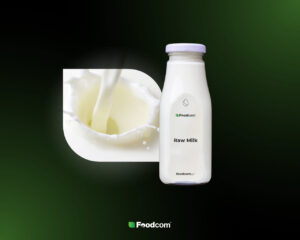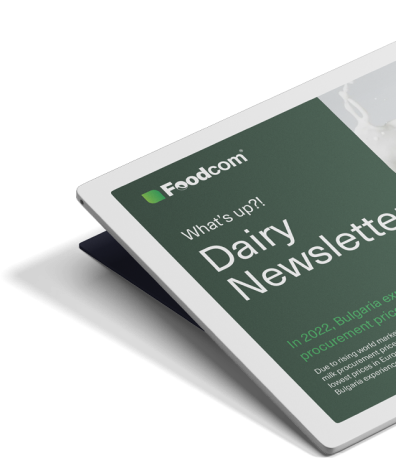- Prices of skimmed milk powder (SMP) are falling amid limited demand and rising stocks.
- The cheese market is losing its balance, with Gouda and Edam prices softening and mozzarella hitting historic lows.
- Butter remains expensive, but growing buyer selectivity is limiting gains; cream prices are high.
- The situation for liquids and whey reflects market volatility and rising production costs amid weak exports.
Welcome Partners!
Welcome back to our newsletter!
The European dairy market is entering a period of increased pressure, with skimmed milk powder and cheese prices falling steadily and most buyers remaining passive, hoping for further corrections. Oversupply, limited export opportunities and high processing costs are exacerbating tensions in the sector. The dairy fats segment is losing momentum – despite persistently high cream prices, butter is facing increasing price resistance. In liquids and whey, volatility and purchasing caution prevail, increasing pressure on producers. There are also warning signs in the background from local markets, including Ireland and Nigeria, which point to increasing regulatory and competitive challenges in the global dairy chain.
Scroll down for detailed market data and forecasts.
Milk powder
European markets for skimmed milk powder (SMP) are under continued downward pressure. Prices for the food product have fallen further, with transactions mainly in the 2300-2370 EUR/MT range. Activity on the spot market remains limited, as most buyers have already covered their Q3 demand or are postponing new purchases in anticipation of further price declines. The overall global sentiment remains subdued due to continued weak demand, particularly in Asian markets.
Producers are facing a difficult situation characterised by high processing costs and limited export dynamics. Stocks are increasing at some plants, although production rates are starting to adjust to the situation. SMP for feed reflects the situation in the food products market, and trade in customised bulk products is at a similar level. Buyers remain conservative, seeking flexibility and price certainty rather than large volumes.
Cheese
The European cheese market is facing a period of imbalance, with continued high domestic production and limited export opportunities. Gouda cheese prices continue to fall and are currently around 4250-4300 EUR/MT on the spot market. Producers have widely divergent stock levels and sales strategies, with some actively offering large volumes while others are holding back in anticipation of better margins. This divergence adds to the complexity of the market and short-term price volatility.
Cheddar cheese is also under pressure, with average prices of 4500-4550 EUR/MT now approaching, and in some regions even below, the break-even level. The export situation remains difficult, especially for products from the UK and Ireland. Sentiment is weakest for mozzarella, with spot prices increasingly falling below 4000 EUR/MT. Demand exists, but it is opportunistic rather than strategic. The situation for emmental cheese remains more stable due to supply constraints, although some indirect pressures are beginning to emerge due to the general weakening of the cheese market.
In the US, cheese production remains active, although milk availability is limited in some regions, particularly in the west. This is driving up costs and may limit further production growth. An increased interest in exporting US cheese has been reported, given its current price advantage over cheeses from Europe and Oceania.
Fats
The European butter market is showing tentative signs of weakening. Despite raw milk shortages, buyers have become more selective, limiting further price increases. Lactic butter is priced at 7100-7300 EUR/MT, with deliveries from Ireland and Poland selling at the lower end of the price range. The premium usually enjoyed by products from Western Europe has narrowed slightly due to the greater price sensitivity of buyers.
Cream prices remain high, which is the lower end of butter prices for now, although future changes will depend on milk supply and cream availability at the end of the summer. Traders are keeping a close eye on developments in the liquid segment, as any decline in cream prices could create room for a correction. The AMF segment continues to be in a relatively stable range, with no major changes and balanced interest from industrial and export buyers.
Liquids
The liquid dairy market remains stable, supported by reduced milk intake in the Western European region. However, there has been a slight weakening of cream prices in Central Europe, while prices remain stable in Western Europe. This has an impact on the overall cost structure of fat products. Buyers are still present, although many are cautious with their purchases due to the volatile availability of products on the spot market.
Prices for skimmed milk concentrate (SMC) have increased, particularly for German products, which are selling at around 2100-2200 EUR/MT. SMC of French origin is still available at slightly lower prices, but in smaller quantities. Limited milk flow and increased demand for high-protein ingredients are limiting supply. The overall situation continues to put pressure on processors due to rising production costs, while product prices in some segments (especially cheese) remain under pressure.
Raw milk prices in Europe remain high and have recently exceeded 600 EUR/MT in several regions.
Whey powder
The whey market situation still lacks a clear direction. Sweet whey powder (SWP) prices are unchanged, with food grade material selling at 1000-1050 EUR/MT and feed grade at around 800-850 EUR/MT. Export demand is weak, particularly in Asia, and there is not enough interest in the domestic market to offset this imbalance. Producers remain cautious, prioritising higher-value derivatives.
Sweet whey concentrate (SWC) prices have increased, causing producers to move away from traditional SWP. This is expected to reduce SWP supply in the near term, although this has not yet translated into significant price changes. Structural changes in whey stream management may limit future powder production, especially if demand for WPC remains high. Overall, the whey segment remains quiet and the near-term outlook is not very bright. Whey protein isolate (WPI) prices in Europe have fallen slightly in recent weeks and have now stabilised at lower levels.
In North America, dry whey prices have increased slightly in some regions, especially for premium and resale products. Stocks of some producers are limited, but export demand remains weak. Production is increasingly focused on whey protein isolates and higher value concentrates, limiting the availability of standard dry whey.
What’s new?
United Kingdom
UK dairy farms are looking to empower themselves through the increasing use of advanced data collection and monitoring technologies. Industry experts highlight that access to real-time information on animal health, nutrition and productivity can lead to more efficient operations, lower costs and improved sustainability. With increasing pressure to meet environmental targets and maintain profitability, the integration of smart farming tools is seen as a key step towards building a more resilient and competitive dairy industry.
Nigeria
Nigerian dairy farmers are struggling to survive as the market is flooded with cheap, subsidised European high fat milk powder (FFMP), which undercuts local milk prices. Without government support, access to finance and investment in infrastructure or high-yielding breeds, local producers are unable to compete, despite the fact that Nigeria imports about 60% of the milk consumed and spends about $1.3 billion a year on it. European companies, mainly from Ireland, target Nigerian consumers by selling FFMP as milk, further threatening domestic production and bankrupting many local farmers.
Ireland
Irish dairy industry leaders are sounding the alarm over new EU requirements linking the nitrate derogation to compliance with the Habitats Directive. The Irish Co-operative Organisation (ICOS) and the Irish Milk Suppliers Association (ICMSA) warn that farmers may now face “appropriate assessments” by individual farms for grazing and fertiliser use near Natura 2000 sites – an unexpected addition that threatens to “break the back of Irish dairying”. They argue that this is causing serious financial and regulatory uncertainty for the 7,000 or so farms benefiting from the derogation, and insist that the government and EU bodies must ensure that all sectors are treated fairly.
![Falling prices with rising costs – dairy in the midst of a seasonal solstice [276th Edition of DAIRY Bulletin] Falling prices with rising costs – dairy in the midst of a seasonal solstice [276th Edition of DAIRY Bulletin]](https://foodcom.pl/wp-content/uploads/2023/08/Foodcom_SA_Newsletter_Dairy-1520x760.jpg)


![Dairy market in seasonal congestion – low activity and rising stocks [275th Edition of DAIRY Newsletter] Dairy market in seasonal congestion – low activity and rising stocks [275th Edition of DAIRY Newsletter]](https://foodcom.pl/wp-content/uploads/2024/06/Foodcom_SA_Dairy_Newsletter_4-600x300.jpg)
![Summary of the dairy market situation – key price developments [274th Edition of the DAIRY Newsletter] Summary of the dairy market situation – key price developments [274th Edition of the DAIRY Newsletter]](https://foodcom.pl/wp-content/uploads/2023/08/Foodcom_Dairy_Newsletter-600x300.jpg)
![The dairy market under pressure: decisive price changes and global trends worth paying attention to! [273th edition of the DAIRY Newsletter] The dairy market under pressure: decisive price changes and global trends worth paying attention to! [273th edition of the DAIRY Newsletter]](https://foodcom.pl/wp-content/uploads/2023/08/Foodcom_Newsletter_Dairy-600x300.jpg)

